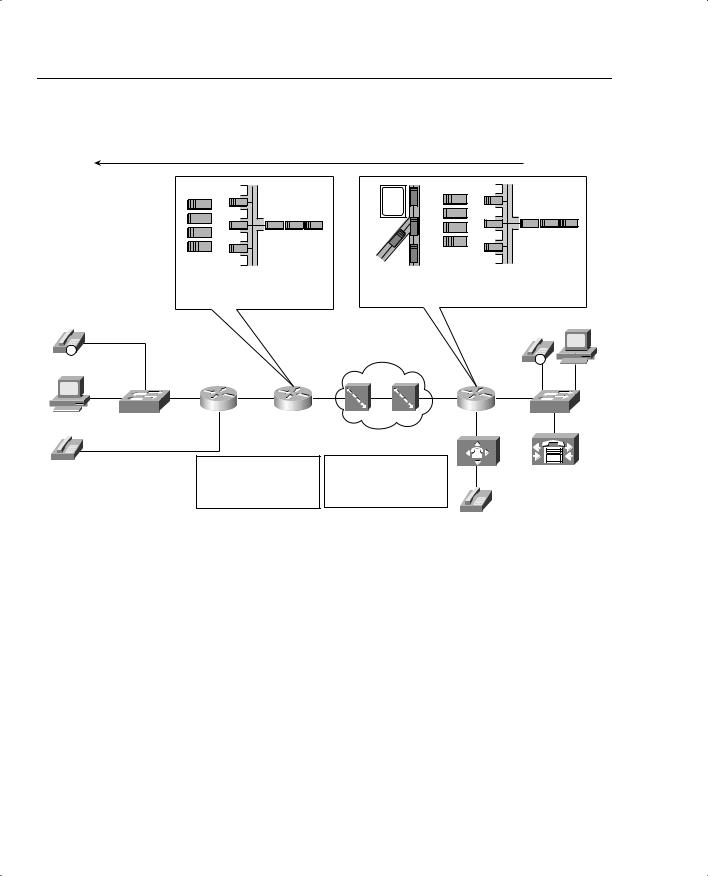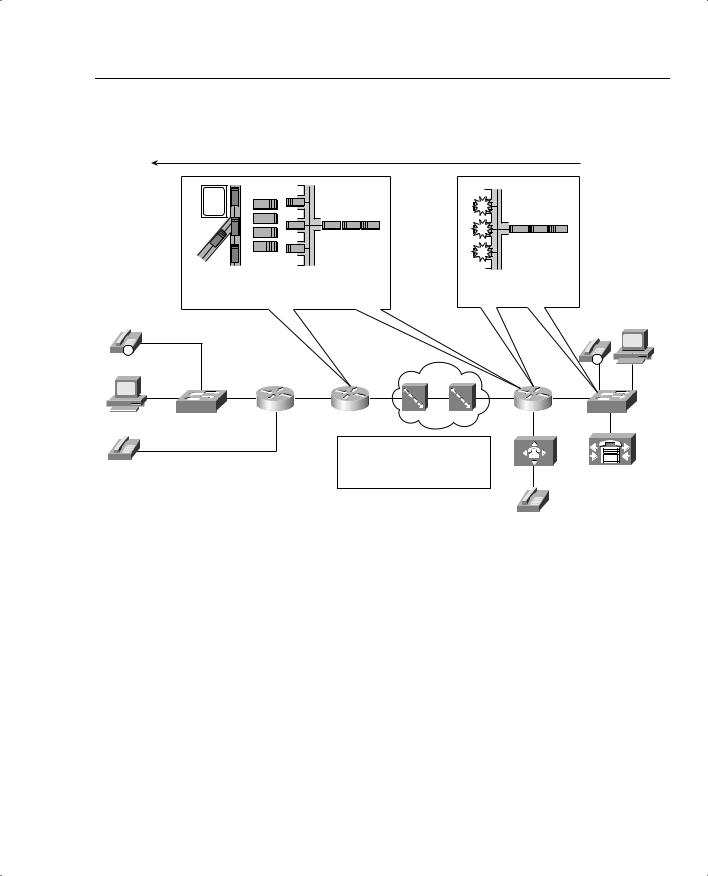
- •QoS Overview
- •“Do I Know This Already?” Quiz
- •QoS: Tuning Bandwidth, Delay, Jitter, and Loss Questions
- •Foundation Topics
- •QoS: Tuning Bandwidth, Delay, Jitter, and Loss
- •Bandwidth
- •The clock rate Command Versus the bandwidth Command
- •QoS Tools That Affect Bandwidth
- •Delay
- •Serialization Delay
- •Propagation Delay
- •Queuing Delay
- •Forwarding Delay
- •Shaping Delay
- •Network Delay
- •Delay Summary
- •QoS Tools That Affect Delay
- •Jitter
- •QoS Tools That Affect Jitter
- •Loss
- •QoS Tools That Affect Loss
- •Summary: QoS Characteristics: Bandwidth, Delay, Jitter, and Loss
- •Voice Basics
- •Voice Bandwidth Considerations
- •Voice Delay Considerations
- •Voice Jitter Considerations
- •Voice Loss Considerations
- •Video Basics
- •Video Bandwidth Considerations
- •Video Delay Considerations
- •Video Jitter Considerations
- •Video Loss Considerations
- •Comparing Voice and Video: Summary
- •IP Data Basics
- •Data Bandwidth Considerations
- •Data Delay Considerations
- •Data Jitter Considerations
- •Data Loss Considerations
- •Comparing Voice, Video, and Data: Summary
- •Foundation Summary
- •QoS Tools and Architectures
- •“Do I Know This Already?” Quiz
- •QoS Tools Questions
- •Differentiated Services Questions
- •Integrated Services Questions
- •Foundation Topics
- •Introduction to IOS QoS Tools
- •Queuing
- •Queuing Tools
- •Shaping and Policing
- •Shaping and Policing Tools
- •Congestion Avoidance
- •Congestion-Avoidance Tools
- •Call Admission Control and RSVP
- •CAC Tools
- •Management Tools
- •Summary
- •The Good-Old Common Sense QoS Model
- •GOCS Flow-Based QoS
- •GOCS Class-Based QoS
- •The Differentiated Services QoS Model
- •DiffServ Per-Hop Behaviors
- •The Class Selector PHB and DSCP Values
- •The Assured Forwarding PHB and DSCP Values
- •The Expedited Forwarding PHB and DSCP Values
- •The Integrated Services QoS Model
- •Foundation Summary
- •“Do I Know This Already?” Quiz Questions
- •CAR, PBR, and CB Marking Questions
- •Foundation Topics
- •Marking
- •IP Header QoS Fields: Precedence and DSCP
- •LAN Class of Service (CoS)
- •Other Marking Fields
- •Summary of Marking Fields
- •Class-Based Marking (CB Marking)
- •Network-Based Application Recognition (NBAR)
- •CB Marking show Commands
- •CB Marking Summary
- •Committed Access Rate (CAR)
- •CAR Marking Summary
- •Policy-Based Routing (PBR)
- •PBR Marking Summary
- •VoIP Dial Peer
- •VoIP Dial-Peer Summary
- •Foundation Summary
- •Congestion Management
- •“Do I Know This Already?” Quiz
- •Queuing Concepts Questions
- •WFQ and IP RTP Priority Questions
- •CBWFQ and LLQ Questions
- •Comparing Queuing Options Questions
- •Foundation Topics
- •Queuing Concepts
- •Output Queues, TX Rings, and TX Queues
- •Queuing on Interfaces Versus Subinterfaces and Virtual Circuits (VCs)
- •Summary of Queuing Concepts
- •Queuing Tools
- •FIFO Queuing
- •Priority Queuing
- •Custom Queuing
- •Weighted Fair Queuing (WFQ)
- •WFQ Scheduler: The Net Effect
- •WFQ Scheduling: The Process
- •WFQ Drop Policy, Number of Queues, and Queue Lengths
- •WFQ Summary
- •Class-Based WFQ (CBWFQ)
- •CBWFQ Summary
- •Low Latency Queuing (LLQ)
- •LLQ with More Than One Priority Queue
- •IP RTP Priority
- •Summary of Queuing Tool Features
- •Foundation Summary
- •Conceptual Questions
- •Priority Queuing and Custom Queuing
- •CBWFQ, LLQ, IP RTP Priority
- •Comparing Queuing Tool Options
- •“Do I Know This Already?” Quiz
- •Shaping and Policing Concepts Questions
- •Policing with CAR and CB Policer Questions
- •Shaping with FRTS, GTS, DTS, and CB Shaping
- •Foundation Topics
- •When and Where to Use Shaping and Policing
- •How Shaping Works
- •Where to Shape: Interfaces, Subinterfaces, and VCs
- •How Policing Works
- •CAR Internals
- •CB Policing Internals
- •Policing, but Not Discarding
- •Foundation Summary
- •Shaping and Policing Concepts
- •“Do I Know This Already?” Quiz
- •Congestion-Avoidance Concepts and RED Questions
- •WRED Questions
- •FRED Questions
- •Foundation Topics
- •TCP and UDP Reactions to Packet Loss
- •Tail Drop, Global Synchronization, and TCP Starvation
- •Random Early Detection (RED)
- •Weighted RED (WRED)
- •How WRED Weights Packets
- •WRED and Queuing
- •WRED Summary
- •Flow-Based WRED (FRED)
- •Foundation Summary
- •Congestion-Avoidance Concepts and Random Early Detection (RED)
- •Weighted RED (WRED)
- •Flow-Based WRED (FRED)
- •“Do I Know This Already?” Quiz
- •Compression Questions
- •Link Fragmentation and Interleave Questions
- •Foundation Topics
- •Payload and Header Compression
- •Payload Compression
- •Header Compression
- •Link Fragmentation and Interleaving
- •Multilink PPP LFI
- •Maximum Serialization Delay and Optimum Fragment Sizes
- •Frame Relay LFI Using FRF.12
- •Choosing Fragment Sizes for Frame Relay
- •Fragmentation with More Than One VC on a Single Access Link
- •FRF.11-C and FRF.12 Comparison
- •Foundation Summary
- •Compression Tools
- •LFI Tools
- •“Do I Know This Already?” Quiz
- •Foundation Topics
- •Call Admission Control Overview
- •Call Rerouting Alternatives
- •Bandwidth Engineering
- •CAC Mechanisms
- •CAC Mechanism Evaluation Criteria
- •Local Voice CAC
- •Physical DS0 Limitation
- •Max-Connections
- •Voice over Frame Relay—Voice Bandwidth
- •Trunk Conditioning
- •Local Voice Busyout
- •Measurement-Based Voice CAC
- •Service Assurance Agents
- •SAA Probes Versus Pings
- •SAA Service
- •Calculated Planning Impairment Factor
- •Advanced Voice Busyout
- •PSTN Fallback
- •SAA Probes Used for PSTN Fallback
- •IP Destination Caching
- •SAA Probe Format
- •PSTN Fallback Scalability
- •PSTN Fallback Summary
- •Resource-Based CAC
- •Resource Availability Indication
- •Gateway Calculation of Resources
- •RAI in Service Provider Networks
- •RAI in Enterprise Networks
- •RAI Operation
- •RAI Platform Support
- •Cisco CallManager Resource-Based CAC
- •Location-Based CAC Operation
- •Locations and Regions
- •Calculation of Resources
- •Automatic Alternate Routing
- •Location-Based CAC Summary
- •Gatekeeper Zone Bandwidth
- •Gatekeeper Zone Bandwidth Operation
- •Single-Zone Topology
- •Multizone Topology
- •Zone-per-Gateway Design
- •Gatekeeper in CallManager Networks
- •Zone Bandwidth Calculation
- •Gatekeeper Zone Bandwidth Summary
- •Integrated Services / Resource Reservation Protocol
- •RSVP Levels of Service
- •RSVP Operation
- •RSVP/H.323 Synchronization
- •Bandwidth per Codec
- •Subnet Bandwidth Management
- •Monitoring and Troubleshooting RSVP
- •RSVP CAC Summary
- •Foundation Summary
- •Call Admission Control Concepts
- •Local-Based CAC
- •Measurement-Based CAC
- •Resources-Based CAC
- •“Do I Know This Already?” Quiz
- •QoS Management Tools Questions
- •QoS Design Questions
- •Foundation Topics
- •QoS Management Tools
- •QoS Device Manager
- •QoS Policy Manager
- •Service Assurance Agent
- •Internetwork Performance Monitor
- •Service Management Solution
- •QoS Management Tool Summary
- •QoS Design for the Cisco QoS Exams
- •Four-Step QoS Design Process
- •Step 1: Determine Customer Priorities/QoS Policy
- •Step 2: Characterize the Network
- •Step 3: Implement the Policy
- •Step 4: Monitor the Network
- •QoS Design Guidelines for Voice and Video
- •Voice and Video: Bandwidth, Delay, Jitter, and Loss Requirements
- •Voice and Video QoS Design Recommendations
- •Foundation Summary
- •QoS Management
- •QoS Design
- •“Do I Know This Already?” Quiz
- •Foundation Topics
- •The Need for QoS on the LAN
- •Layer 2 Queues
- •Drop Thresholds
- •Trust Boundries
- •Cisco Catalyst Switch QoS Features
- •Catalyst 6500 QoS Features
- •Supervisor and Switching Engine
- •Policy Feature Card
- •Ethernet Interfaces
- •QoS Flow on the Catalyst 6500
- •Ingress Queue Scheduling
- •Layer 2 Switching Engine QoS Frame Flow
- •Layer 3 Switching Engine QoS Packet Flow
- •Egress Queue Scheduling
- •Catalyst 6500 QoS Summary
- •Cisco Catalyst 4500/4000 QoS Features
- •Supervisor Engine I and II
- •Supervisor Engine III and IV
- •Cisco Catalyst 3550 QoS Features
- •Cisco Catalyst 3524 QoS Features
- •CoS-to-Egress Queue Mapping for the Catalyst OS Switch
- •Layer-2-to-Layer 3 Mapping
- •Connecting a Catalyst OS Switch to WAN Segments
- •Displaying QoS Settings for the Catalyst OS Switch
- •Enabling QoS for the Catalyst IOS Switch
- •Enabling Priority Queuing for the Catalyst IOS Switch
- •CoS-to-Egress Queue Mapping for the Catalyst IOS Switch
- •Layer 2-to-Layer 3 Mapping
- •Connecting a Catalyst IOS Switch to Distribution Switches or WAN Segments
- •Displaying QoS Settings for the Catalyst IOS Switch
- •Foundation Summary
- •LAN QoS Concepts
- •Catalyst 6500 Series of Switches
- •Catalyst 4500/4000 Series of Switches
- •Catalyst 3550/3524 Series of Switches
- •QoS: Tuning Bandwidth, Delay, Jitter, and Loss
- •QoS Tools
- •Differentiated Services
- •Integrated Services
- •CAR, PBR, and CB Marking
- •Queuing Concepts
- •WFQ and IP RTP Priority
- •CBWFQ and LLQ
- •Comparing Queuing Options
- •Conceptual Questions
- •Priority Queuing and Custom Queuing
- •CBWFQ, LLQ, IP RTP Priority
- •Comparing Queuing Tool Options
- •Shaping and Policing Concepts
- •Policing with CAR and CB Policer
- •Shaping with FRTS, GTS, DTS, and CB Shaping
- •Shaping and Policing Concepts
- •Congestion-Avoidance Concepts and RED
- •WRED
- •FRED
- •Congestion-Avoidance Concepts and Random Early Detection (RED)
- •Weighted RED (WRED)
- •Flow-Based WRED (FRED)
- •Compression
- •Link Fragmentation and Interleave
- •Compression Tools
- •LFI Tools
- •Call Admission Control Concepts
- •Local-Based CAC
- •Measurement-Based CAC
- •Resources-Based CAC
- •QoS Management Tools
- •QoS Design
- •QoS Management
- •QoS Design
- •LAN QoS Concepts
- •Catalyst 6500 Series of Switches
- •Catalyst 4500/4000 Series of Switches
- •Catalyst 3550/3524 Series of Switches
- •Foundation Topics
- •QPPB Route Marking: Step 1
- •QPPB Per-Packet Marking: Step 2
- •QPPB: The Hidden Details
- •QPPB Summary
- •Flow-Based dWFQ
- •ToS-Based dWFQ
- •Distributed QoS Group–Based WFQ
- •Summary: dWFQ Options

86 Chapter 2: QoS Tools and Architectures
Foundation Topics
This chapter introduces the long list of QoS tools and two important QoS architectures— differentiated services (DiffServ) and integrated services (IntServ). You can think of QoS implementation as building a house. To properly build a house, you certainly need (and use) a large variety of tools. An experienced builder might be able to use the tools to build a house without an architectural plan. With the architectural plans, however, an experienced house builder can build a better house! Similarly, an experienced network engineer can use QoS tools with good results, without considering the DiffServ and IntServ architectures. By considering these architectures, however, a network engineer can use the tools to implement the QoS policies more consistently and efficiently, and thereby guarantee better QoS.
This chapter begins with an introduction to the various QoS tools in IOS. Then a section titled “The Good-Old Common Sense QoS Model” identifies where you might use a tool in a network, without considering the two formal QoS models. The chapter closes with one section on each of the two formal specifications for QoS architectures and conventions, namely the DiffServ and IntServ architectures.
Introduction to IOS QoS Tools
Ultimately, this book will help you pass one or two QoS exams (the CCIP QoS exam and the Cisco Channel Partner DQOS exam). Both exams cover a wide variety of types of QoS tools. This chapter lists the tools covered on the DQOS exam; any tools only covered on the QOS exam are listed in Appendix B, “Topics on the CCIP QoS Exam.”
Of particular note, neither exam covers the implementation details of these tools on LAN switches, so the configurations and features of QoS tools on LAN switches is not listed in this section. Look to Chapter 10, “LAN QoS,” for further details about how these QoS tools operate in the LAN. Also make sure to check www.cisco.com, and www.ciscopress.com/1587200589, for the latest information about any changes to the exams.
The coverage here begins with an explanation of classification and marking tools, followed by queuing tools, shaping and policing tools, congestion-avoidance tools, link-efficiency tools, call admission control (CAC), and QoS management tools.
Classification and Marking
Almost every QoS tool uses classification to some degree. To put one packet into a different queue than another packet, the IOS must somehow differentiate between the two packets. To perform header compression on RTP packets, but not on other packets, the IOS must determine which packets have Real Time Protocol (RTP) headers. To shape data traffic going into a Frame Relay network, so that the voice traffic gets enough bandwidth, the IOS must differentiate

Introduction to IOS QoS Tools 87
between Voice over IP (VoIP) and data packets. If an IOS QoS feature needs to treat two packets differently, you must use classification.
Classification involves differentiating one packet from another, typically by examining fields inside the headers. After classification, a QoS tool can treat packets in one class differently than others. To just give all VoIP traffic preference over all other traffic, the queuing tool would need to classify traffic into one of two categories: VoIP or not-VoIP.
Because most QoS tools need to differentiate between packets, most QoS tools have classification features. In fact, you may already know something about several of the QoS tools described in this book. You may realize that you already know how to perform classification using some of those tools. For instance, many QoS tools enable you to classify using access-control lists (ACLs)—for instance, if ACL 101 “permits” a packet, the packet falls into one queue; if ACL 102 permits a packet, it is placed in a second queue; and so on. In one way of thinking, queuing could instead be called “classification and queuing,” because the queuing feature must somehow decide which packets end up in which queue. Similarly, traffic shaping could be called “classification and traffic shaping,” policing could be called “classification and policing,” and so on. Because most QoS tools classify traffic, however, the names of most QoS tools never evolved to mention the classification function of the tool.
Only one category of QoS tool, called classification and marking, highlights the classification feature in the name of the tool. For other tools, the classification function is just part of the story; with classification and marking tools, classification is the whole point of the tool. To appreciate the need for classification and marking tools, consider Figure 2-1.
The figure shows the QoS policies for traffic flowing right to left. R3 performs queuing and shaping, and R2 performs queuing only. However, for both sets of queues, and for the shaping function, classification must occur. The classification part of the effort seems to be a simple task, but it may cause many comparisons to be made. For instance, each packet exiting R3’s S0 and R2’s S0 interfaces might be compared for the following:
•From source address 10.1.1.1, TCP source port 80 (Server1 web traffic)
•Using User Datagram Protocol (UDP), port number range 16384 to 32767 (voice pay- load)—may also want to check IP address ranges to match IP Phones’ voice subnets, or voice gateway IP addresses
•Using TCP port 1720 (H.323 voice signaling)
•Using TCP port range 11000 to 11999 (Voice signaling)
•Using TCP port 1719 (Voice signaling)
•Using TCP port 2000 to 2002 (Skinny voice signaling)
•Using UDP port 2427 and 2428 (MGCP voice signaling)

88 Chapter 2: QoS Tools and Architectures
Figure 2-1 Sample Network, with Queuing and Shaping Tools Enabled
Figure Shows QoS for Packets Flows Right-to-Left
Bit Rate
|
Limit |
|
x bps |
Slow |
Down |
|
Queuing |
Classify |
Shaping |
Queuing |
Classify |
Server1
IP |
|
|
|
|
|
|
|
|
|
|
|
|
|
|
|
|
|
|
IP |
Hannah |
|
|
|
|
|
|
|
|
|
|
|
|
|
|
|
|
|
|
FA0/0 |
SW1 |
R1 |
s0 |
s0 |
R2 |
s1 |
T1 |
s0/0 |
R3 |
SW2 |
Queuing Policy (R2 and R3):
201 Q1: Voice
Q2: Voice Signaling
Q3: Web Traffic from Server 1 Q4: All Other Traffic
Shaping Policy (R3 Only):
40kbps for all traffic from Server1 20kbps for all other Data
Do not shape voice (let it have the rest of the bandwidth)
301
Classification and marking tools simplify the classification process of the other QoS tools. Even with seemingly simple requirements, the classification functions can require many comparisons to every packet. Rather than have each tool do extensive packet matching, classification and marking tools do the extensive classification once, and mark a field in a packet header. The remaining QoS tools just need to look for this marked field, simplifying the repetitive classification work.
The two most commonly used marking fields in the IP header are the IP Precedence field, and the Differentiated Services Code Point (DSCP) field. You will see the details of these two fields, along with the other fields that can be used for marking, later in this chapter. Consider Figure 2-2, where classification and marking is performed on input of R3.
The queuing and shaping features can now classify more efficiently. Queuing is still performed on R3 and R2, and shaping is still performed on R3. However, the extensive matching logic for each packet done for all incoming traffic can be performed once on R3’s FA0/0 interface, or once on one of the LAN switches, such as SW3. Once marked, the other QoS tools can react to the marked value, which each QoS tool can efficiently match in the end-to-end path through the network.

Introduction to IOS QoS Tools 89
Figure 2-2 Sample Network, with Simplified Classification as a Result of Classification and Marking
Figure Shows QoS for Packets Flows Right-to-Left
|
|
Mark |
|
Bit Rate |
|
|
Limit |
|
|
x bps |
X |
|
|
|
|
Down |
Y |
|
|
|
Slow |
|
Z |
Shaping |
Queuing |
Classify Easily, |
Mark with IP Precedence |
(R3 Only in |
|
Based on IP |
Mark at Ingress |
This Example) |
|
Precedence |
Mark on Switch if Possible |
Server 1
IP |
|
|
|
|
|
|
|
|
|
|
|
|
|
|
|
|
|
|
IP |
Hannah |
|
|
|
|
|
|
|
|
|
|
|
|
|
|
|
|
|
|
FA0/0 |
SW1 |
R1 |
s0 |
s0 |
R2 |
s1 |
T1 |
s0/0 |
R3 |
SW2 |
|
|
|
|
Classification and Marketing |
|
|
|
|
|
|
|
|
|
Mark Voice with Precedence 5 |
|
|
|
|
|
201 |
|
|
|
Mark Voice Signaling with Precedence 3 |
|
|
|
||
|
|
|
Mark Server1 Traffic with Precedence 2 |
|
|
|
|||
|
|
|
|
All Else Is Marked IP Precedence 0 |
|
|
|
|
|
301
Classification and Marking Tools
A variety of classification and marking tools exist. Classification and marking tools first classify by looking at something inside each packet; you can compare these tools by listing the fields the tool can examine. Classification and marking tools mark the frame or packet based on the earlier comparisons; you can compare these tools by listing the fields that can be marked. Some classification and marking tools also perform other functions, as noted in Table 2-2.
Chapter 3 explains the details of each of the tools, all the marked fields, and the configuration of each tool.
